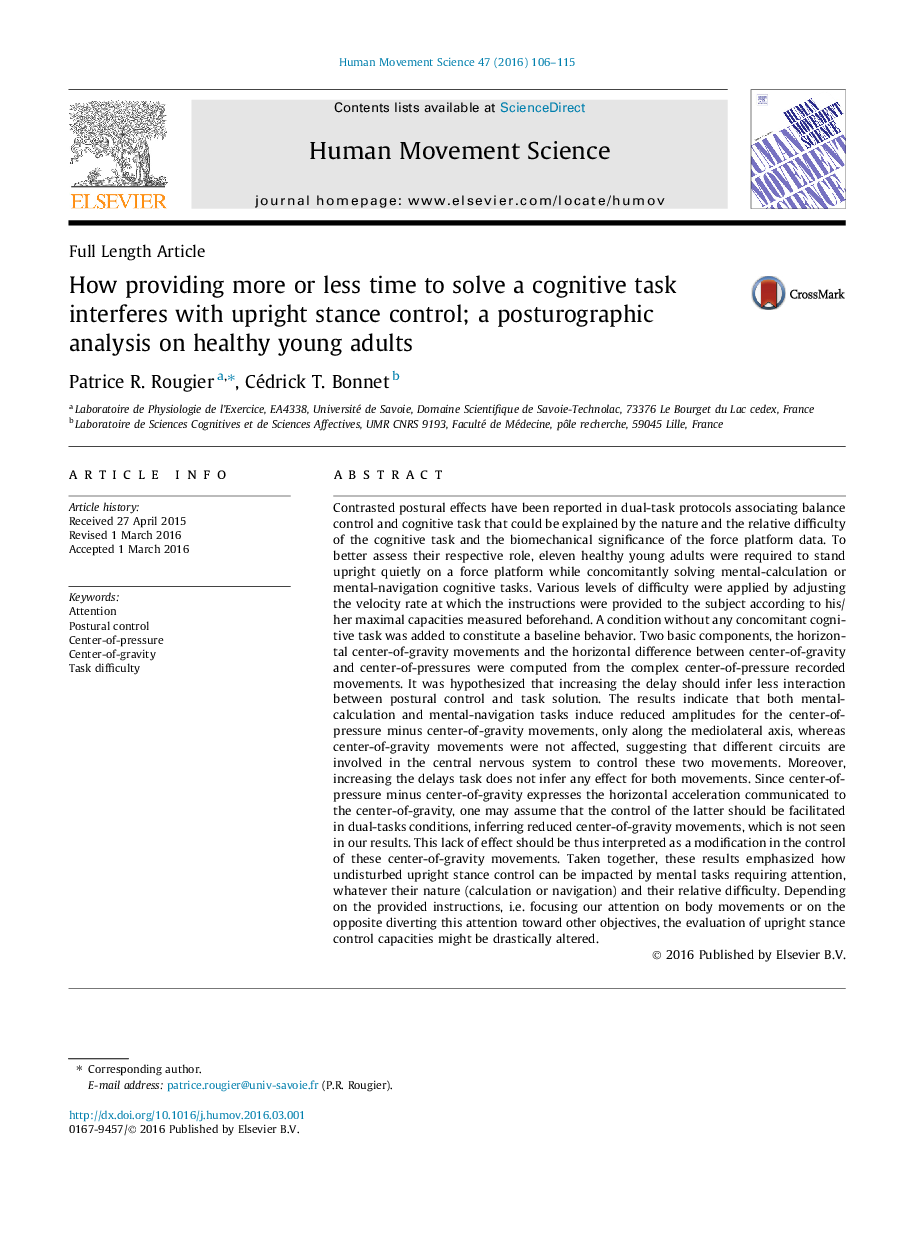| کد مقاله | کد نشریه | سال انتشار | مقاله انگلیسی | نسخه تمام متن |
|---|---|---|---|---|
| 7291467 | 1474218 | 2016 | 10 صفحه PDF | دانلود رایگان |
عنوان انگلیسی مقاله ISI
How providing more or less time to solve a cognitive task interferes with upright stance control; a posturographic analysis on healthy young adults
ترجمه فارسی عنوان
چگونگی تأمین زمان بیشتر یا کمتر برای حل یک کار شناختی، با کنترل موضعی راست روبرو می شود. یک تجزیه و تحلیل پستوگرافی در بزرگسالان جوان سالم
دانلود مقاله + سفارش ترجمه
دانلود مقاله ISI انگلیسی
رایگان برای ایرانیان
کلمات کلیدی
توجه کنترل پستی مرکز فشار، مرکز گرانش، مشکل کار
ترجمه چکیده
اثرات متعادل افتراقی در پروتکل های دوتایی گزارش شده است که کنترل توازن وظیفه شناختی را مرتبط می کند که می تواند به واسطه ماهیت و مشکل نسبی وظیفه شناختی و اهمیت بیومکانیک اطلاعات پلت فرم نیروی توضیح داده شود. به منظور ارزیابی نقش مربوطه آنها، یازده سالمند جوان سالم بایستی در یک پلتفرم نیروی محرمانه ایستاده باشند و همزمان با حل مسائل محاسباتی ذهنی یا وظایف شناختی روان شناختی حل شوند. سطوح مختلف دشواری با تنظیم نرخ سرعت که در آن دستورالعمل ها به موضوع داده می شود با توجه به ظرفیت حداکثر خود که قبل از اندازه گیری اندازه گیری شده بود، اعمال شد. یک وضعیت بدون هیچ مشکلی مرتبط با شناختی برای ایجاد یک رفتار پایه اضافه شد. دو عنصر اساسی، حرکات حرکتی افقی مرکزی و اختلاف افقی بین مرکز جاذبه و مرکز فشار از حرکات ثبت شده مرکزی فشار محاسبه شده است. فرض بر این بود که افزایش تاخیر باید بین تعاملات کمتر بین کنترل پستی و راه حل کار را نتیجه بگیرد. نتایج نشان می دهد که هر دو وظیفه محاسبه ذهنی و وظایف ذهنی منجر به کاهش دامنه برای مرکز فشار منهای حرکت حرکات مرکز گرانش تنها در امتداد محور دو طرفه، در حالی که حرکات مرکز جاذبه تحت تاثیر قرار نیست، نشان می دهد که مدارهای مختلف در سیستم عصبی مرکزی برای کنترل این دو حرکت دخیل هستند. علاوه بر این، افزایش کار وظایف تاخیر هیچ تاثیری برای هر دو جنبش ندارد. از آنجایی که مرکز فشار منهای مرکز گرانش شتاب افقی را به مرکز گرانش نشان می دهد، می توان فرض کرد که کنترل دومی باید در شرایط دو وظیفه ای تسهیل شود، در نتیجه کاهش مرکز جاذبه حرکات، که در نتایج ما دیده نمی شود. بنابراین این فقدان اثر باید به عنوان یک اصلاح در کنترل این حرکات مرکز جاذبه تفسیر شود. با هم بر هم خوردن این نتایج تأکید کرد که کنترل دقیق وضعیت نزولی تحت تأثیر وظایف ذهنی که نیاز به توجه دارند، هر چه که هست (محاسبه یا ناوبری) و مشکل نسبی آنها باشد. بسته به دستورالعمل های ارائه شده، یعنی تمرکز توجه ما به حرکات بدن و یا در مقابل، این توجه را به سوی اهداف دیگر هدایت می کند، ارزیابی توانایی های کنترل درست ایستادگی ممکن است به شدت تغییر کند.
موضوعات مرتبط
علوم زیستی و بیوفناوری
علم عصب شناسی
علوم اعصاب شناختی
چکیده انگلیسی
Contrasted postural effects have been reported in dual-task protocols associating balance control and cognitive task that could be explained by the nature and the relative difficulty of the cognitive task and the biomechanical significance of the force platform data. To better assess their respective role, eleven healthy young adults were required to stand upright quietly on a force platform while concomitantly solving mental-calculation or mental-navigation cognitive tasks. Various levels of difficulty were applied by adjusting the velocity rate at which the instructions were provided to the subject according to his/her maximal capacities measured beforehand. A condition without any concomitant cognitive task was added to constitute a baseline behavior. Two basic components, the horizontal center-of-gravity movements and the horizontal difference between center-of-gravity and center-of-pressures were computed from the complex center-of-pressure recorded movements. It was hypothesized that increasing the delay should infer less interaction between postural control and task solution. The results indicate that both mental-calculation and mental-navigation tasks induce reduced amplitudes for the center-of-pressure minus center-of-gravity movements, only along the mediolateral axis, whereas center-of-gravity movements were not affected, suggesting that different circuits are involved in the central nervous system to control these two movements. Moreover, increasing the delays task does not infer any effect for both movements. Since center-of-pressure minus center-of-gravity expresses the horizontal acceleration communicated to the center-of-gravity, one may assume that the control of the latter should be facilitated in dual-tasks conditions, inferring reduced center-of-gravity movements, which is not seen in our results. This lack of effect should be thus interpreted as a modification in the control of these center-of-gravity movements. Taken together, these results emphasized how undisturbed upright stance control can be impacted by mental tasks requiring attention, whatever their nature (calculation or navigation) and their relative difficulty. Depending on the provided instructions, i.e. focusing our attention on body movements or on the opposite diverting this attention toward other objectives, the evaluation of upright stance control capacities might be drastically altered.
ناشر
Database: Elsevier - ScienceDirect (ساینس دایرکت)
Journal: Human Movement Science - Volume 47, June 2016, Pages 106-115
Journal: Human Movement Science - Volume 47, June 2016, Pages 106-115
نویسندگان
Patrice R. Rougier, Cédrick T. Bonnet,
